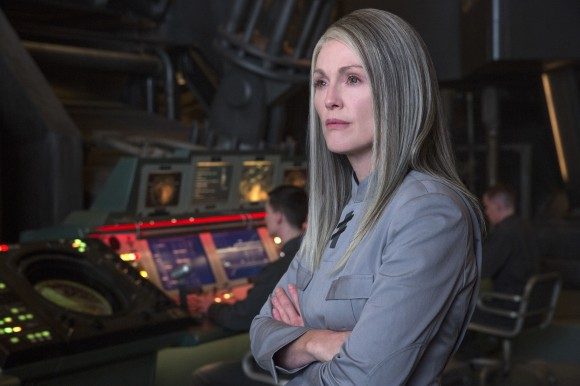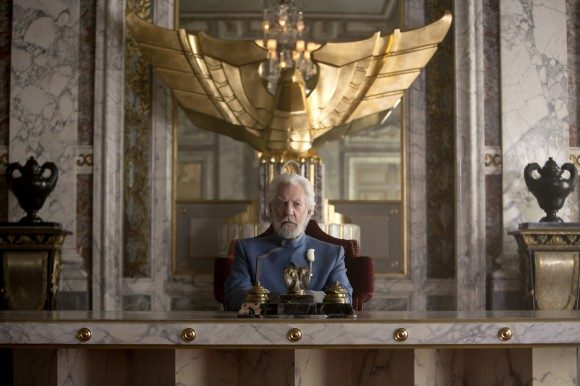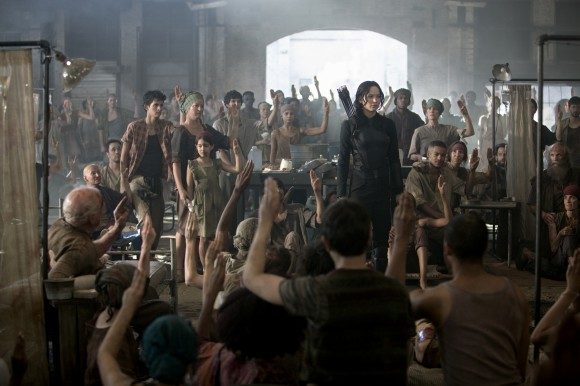I’ll admit to utter ambivalence as I walked into The Hunger Games: Mockingjay – Part 1, and not just because the title is long and boring enough to put anyone to sleep. I read the Hunger Games books, I watched the first two movies, and while it’s all fun enough, I was never captivated in the same way I was with, say, Ender’s Game (the book, not the movie) or The Lord of the Rings (both books and movies). I’ll admit that I went into Mockingjay hopeful for a passably entertaining movie and with zero faith I’d find much of anything more.
And then I found a very good movie.Mockingjay – Part 1 won’t redefine the other Hunger Games films for you, but it’s a more than competent second act in a three part opus. Second act? Well, yes. You kind of have to take The Hunger Games and Catching Fire as one, oddly enough, with parts one and two of Mockingjay actually serving as discreet portions of the overall story. When you look at trilogies in general, there’s a general arc of, “What was, what is, and what will be,” when you trace the narrative pathway. The first part sets up the world and pushes it towards crisis, the second part lives within that crisis, and the third part illuminates the path out to a new world. All of this is becoming a little divorced from Mockingjay itself, so to bring things back around, let’s suffice it to say that Part 1 is definitely the piece of this that takes place in the midst of crisis (more on this in a minute) and only a basic understanding of what happened in the first two movies and who the major characters are is required to jump in here.
So Mockingjay – Part 1 finds us waking up with Katniss Everdeen (Jennifer Lawrence), who’s now in the previously-thought-dead-but-actually-in-open-rebellion District 13 trying to recover from PTSD from another time in the Hunger Games arena and survivor’s guilt over leaving Peeta (Josh Hutcherson) and the other tributes in the clutches of the Capitol. The District 13 leaders, namely President Alma Coin (Julianne Moore) and Capitol defector Plutarch Heavensbee (Philip Seymour Hoffman), want to use Katniss’s symbolic importance as “the Mockingjay” in a series of propaganda pieces to unite the districts against the Capitol. As she showed in the earlier films, Katniss doesn’t want to worry about the movements of statesmen, but just wants a safe, small life for her family and others she’s close to and personally connected with. She agrees with Coin’s requests, though, on the condition that Coin and District 13 make every effort to free Peeta and the other former tributes and provide them with full amnesty from any actions taken while in the clutches of President Snow (Donald Sutherland) and the Capitol. Katniss’s personal vendetta against the ever-manipulative Snow also figures in pretty heavily, at least when it comes to the psychological moves the various players start making across this chessboard.
And psychology is important, because a huge part of why Mockingjay works so well is that we understand very clearly the motivations of the many characters in play and get to see their convictions meaningfully tested. There are the nation-building movements of Coin, District 13, and the rebels among the other districts facing off against Snow and the Capitol. Katniss is not a patriot, not going to abandon herself to the District 13 cause. She wants Snow to fall, but she also wants Peeta and her family safe. She also doesn’t seem to completely trust Coin, although that might be paranoia over how she’s been manipulated since she entered the public eye during the first Hunger Games. Then she has personal connections to the District 13 like Gale (Liam Hemsworth), who is fully committed to the cause, but also to the people of the Capitol, if not the Capitol itself, through Effie Trinket (Elizabeth Banks), who is now also in District 13 and more pitiable than ever.
Above all, the movie is about Katniss’s struggle to ensure her actions are her own while nearly everyone around her would instead use her for a their own purposes. It’s an incredibly compelling personal story that interacts heavily with the visually impressive set pieces of the larger conflict. The action reflects the psychological anguish of the main character, and the movie consistently finds way to embody the abstract tensions Katniss is trying to navigate. A lot of credit has to go to director Francis Lawrence (I Am Legend) and screenwriters Peter Craig (The Town) and Danny Strong (Lee Daniels’ The Butler) for making a movie that is so cohesive and complete unto itself as a part of this larger tale.
On that note, there were two other movies I found myself returning to as points of comparison while thinking about Mockingjay – Part 1. One is the poster boy for sci-fi sequels done right, The Empire Strikes Back, and the other is this year’s Captain America: The Winter Soldier. Starting with the latter, as I wrote this past April it can be difficult to asses a movie like this which is so clearly a part of a broader story. Since the book Mockingjay was split into two parts, it’s easy to conceptualize this movie as just another piece of a continually evolving story. But as I’ve already said, Mockingjay – Part 1 argues for itself; it’s not just another installment, it’s the middle act in a very particular story. So started thinking about how well this movie could stand entirely on its own. And I think the answer is that it could stand pretty well, but I don’t think that’s quite the right question either.
Like Empire, Mockingjay – Part 1 relies on some familiarity with its prior installments. It does a pretty good job of dropping you into a fully realized world, one that’s more believably lived-in than ever, but there’s not enough to catch someone up who has no knowledge for the first act. But unlike The Winter Soldier (which, for the record, I liked), Mockingjay – Part 1 concludes with a game plan for tying up the narrative loose ends it chooses to leave. Empire left us with a very particular mission: find Han Solo. We were ok with the cliffhanger because there were meaningful narrative and character arcs concluded within the movie, and we were pointed to the exact spot where the sequel would pick up. Mockingjay works the same way. It’s not that it could stand fully independent of its other parts, but that it is fulfilling as a discreet segment within a unified whole.
The Verdict: 4 out of 5
Yes, I was a little surprised, but this is not simply the result of low expectations = higher score. The Hunger Games: Mockingjay Part 1 is a legitimately good movie that makes excellent use of its characters, their motivations, and an exciting narrative setup. Where it really rises is in its ability to play them off one another, smartly intermingling character and narrative development in a way the series hasn’t achieved until this point. Treat the first two Hunger Games movies as the first act of the story, this movie as act two, and get excited for the conclusion in Mockingjay – Part 2.




